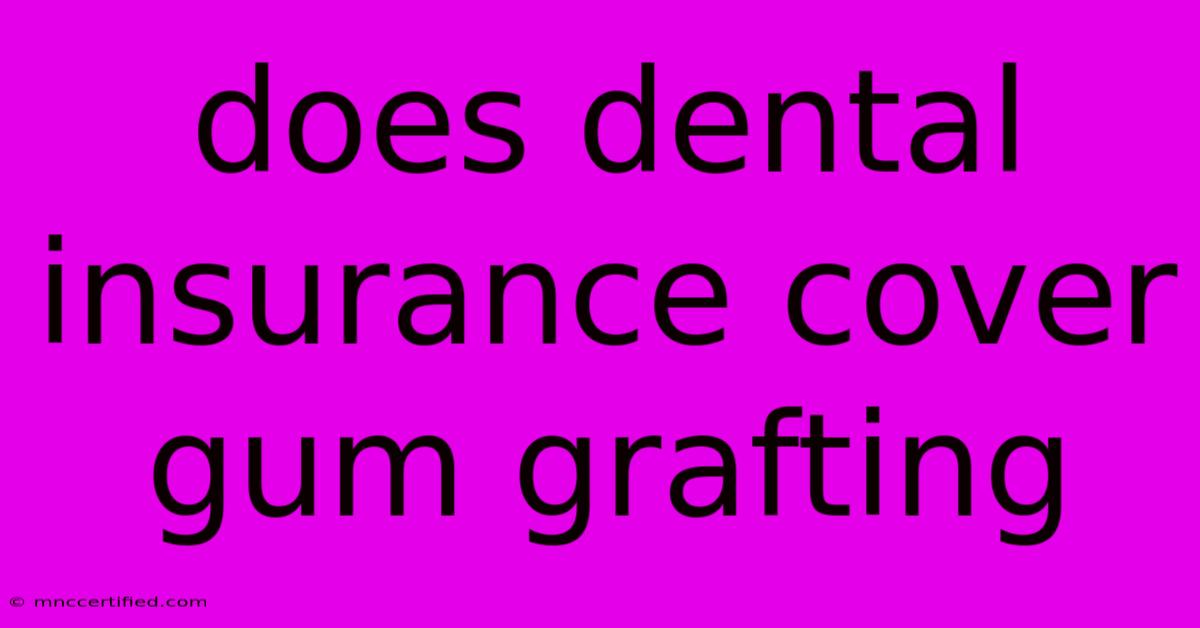Does Dental Insurance Cover Gum Grafting

Table of Contents
Does Dental Insurance Cover Gum Grafting? A Comprehensive Guide
Gum grafting, a surgical procedure to restore lost gum tissue, can be a life-changing solution for many individuals struggling with gum recession, sensitivity, or other dental problems. However, the cost of this procedure can be a significant barrier, prompting the question: Does dental insurance cover gum grafting?
The short answer is it depends. While some dental insurance plans might cover gum grafting, many don't. Understanding the factors that influence coverage is crucial.
Factors Affecting Gum Grafting Coverage
Here are the key factors that determine if your insurance plan covers gum grafting:
- Plan Type: Different dental insurance plans have varying levels of coverage.
- Basic plans: These often cover only essential procedures like cleanings and fillings, rarely including gum grafting.
- Comprehensive plans: They offer broader coverage, potentially including gum grafting, but often require specific medical necessity criteria.
- Medical Necessity: Your insurance provider will likely require documentation from your dentist demonstrating the medical necessity of the gum grafting procedure. This involves proving that the procedure is required to address a specific medical condition rather than purely cosmetic reasons.
- Pre-existing Conditions: If you have a pre-existing condition like gum disease, the insurer may require you to have undergone a period of non-surgical treatment before covering gum grafting.
- Benefit Limits: Most dental insurance plans have annual benefit limits, meaning you might face out-of-pocket expenses if the procedure exceeds the limit.
- Waiting Periods: Some dental insurance plans have waiting periods before certain procedures are covered, potentially impacting gum grafting coverage.
Understanding Your Coverage
The best way to determine your coverage is to contact your dental insurance provider directly. They can provide you with:
- Specific information about your plan: Clarify whether gum grafting is a covered procedure.
- Coverage details: Understand any pre-authorization requirements, medical necessity documentation needs, and benefit limits.
- Estimated out-of-pocket costs: Get a clear picture of your financial responsibility for the procedure.
Alternatives to Insurance Coverage
If your dental insurance doesn't cover gum grafting, there are other ways to manage the costs:
- Financing Options: Explore options like dental financing plans offered by your dentist or financial institutions.
- Dental Savings Accounts: Use funds accumulated in a Health Savings Account (HSA) or Flexible Spending Account (FSA) to pay for the procedure.
- Negotiating with your Dentist: Discuss payment plans or discounts with your dentist.
When Gum Grafting is Necessary
While insurance coverage might be a concern, remember that gum grafting is a crucial procedure in many cases. It can:
- Prevent Tooth Loss: Receding gums can expose tooth roots, making them vulnerable to decay and infection.
- Improve Aesthetics: Gum grafting can restore a natural smile line and improve the overall appearance of your teeth.
- Enhance Oral Hygiene: By providing more gum tissue, grafting makes it easier to maintain good oral hygiene.
- Reduce Sensitivity: Exposed tooth roots can cause pain and sensitivity. Gum grafting can address these issues.
Take Control of Your Oral Health
Don't let financial concerns prevent you from seeking necessary dental care. Understand your insurance coverage, explore alternative payment options, and consult with your dentist about the most effective treatment plan for your specific needs. Remember, investing in your oral health is an investment in your overall well-being.

Thank you for visiting our website wich cover about Does Dental Insurance Cover Gum Grafting. We hope the information provided has been useful to you. Feel free to contact us if you have any questions or need further assistance. See you next time and dont miss to bookmark.
Featured Posts
-
Does Dental Insurance Cover Wisdom Teeth
Nov 08, 2024
-
Hofmeister Insurance Hillsboro Wisconsin
Nov 08, 2024
-
Starbucks Holiday Menu 2024 Full List
Nov 08, 2024
-
Outer Banks Season 4 Finale Explained
Nov 08, 2024
-
Outer Banks Season 5 Latest News And Rumors
Nov 08, 2024